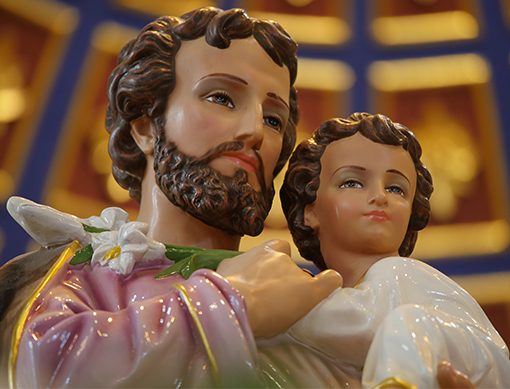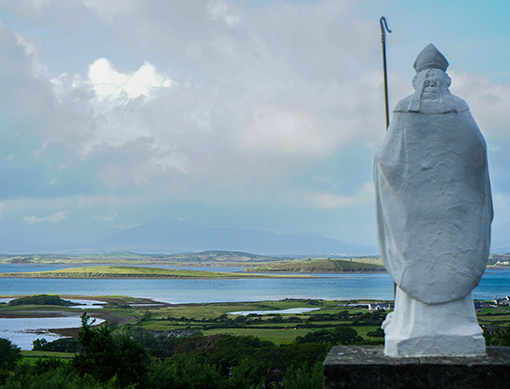As we pulled into the diner for lunch, I noticed a large black bird with a wide wingspan swooping overhead. As I exited my car and walked toward the building, I realized the bird, a black vulture, had descended on the roof edge along the gutter, now perched wing-to-wing with a second vulture. As we got closer, we could see them both looking intently at us with beady eyes, their heads moving ever so slightly lower as we got closer.
"Keep moving," said my husband with a chuckle, "so they don't think we're their next meal."
I laughed, but it was eerie, knowing how intently they were watching us. I wondered if there was something to learn from the experience.
As scavengers, vultures have a tarnished image. They live off dead and rotting carcasses, something abhorrent to people. They are equated with death and destruction and things foul. But without vultures and similar members of the avian clean-up and sanitation crew, humanity would suffer.
After all, God created every living creature, vultures and humans, alike, with a purpose. Vultures play a significant role in the life cycle, providing opportunities for regeneration, purification, and new beginnings. They get rid of the old, not only what's not needed but what can be detrimental to humans.
Now, when I see a vulture being a vulture on the side of the road or flying overhead, I consider what it is that needs purification and renewal in my life. What is happening in my life that is detrimental to my mental, physical, spiritual life, or family life? What resources are available to me to help me make that change?
Most importantly, I remember that the vulture is living its God-given purpose, which causes me to reflect on whether I am living my purpose, as well.
One of my favorite quotes about creation comes from famed Russian novelist and Orthodox Christian, Fyodor Dostoyevsky, who wrote, "Love all God's creation, the whole and every grain of sand of it. Love every leaf, every ray of God's light. Love the animals, love the plants, love everything. If you love everything, you will perceive the divine mystery in things. Once you perceive it, you will begin to comprehend it better every day. And you will come at last to love the whole world with an all-embracing love."
Vultures may not be the most loveable of birds, but they have been part of my lesson that God's creation has the power to teach us about God, about ourselves, and the relationships that bind us if we are willing to be receptive students.
Mary Regina Morrell is a Catholic journalist, author, and syndicated columnist who has served the dioceses of Metuchen and Trenton, New Jersey, and RENEW International in the areas of catechesis and communication.
On my kitchen counter is a small statue of the Blessed Virgin Mary. Every day I light a tea candle at the foot of the statue and pray in gratitude for big and small blessings and offer prayers of petition for my family, friends, and communities.
Recently, I added a second statue, that of Saint Joseph. Most often, he is lying on his side resting on small pieces of paper—my prayer intentions. It’s a practice I borrowed from Pope Francis, who has long had a devotion to Saint Joseph and keeps a statue of the sleeping Saint Joseph in his office.
The Holy Father acknowledged, “When I have a problem, a difficulty, I write a little note and I put it underneath Saint Joseph so that he can dream about it! In other words, I tell him: Pray for this problem! … Do not forget Saint Joseph who sleeps! Jesus slept with the protection of Joseph.”
I love this image of the sleeping saint because like many of us, I, too, often make a decision to “sleep on it,” when I have a problem or decision to make. Sometimes, I wake up with a sense that God has given me my marching orders but my reply is not always the internal, silent, yes of Saint Joseph.
My initial reaction is just as likely to be “Seriously?” “You’ve got to be kidding,” or “Ummm, I don’t think so.” It might take me some time to come around to what God wants, but Joseph does not falter.
The Church will soon celebrate the feast of Saint Joseph the Worker on May 1. But that is not the only time the earthly father of Jesus is celebrated on the liturgical calendar. His primary feast on March 19, the Solemnity of Saint Joseph, honors him as the husband of Mary, the Blessed Mother. On the Sunday after Christmas, he is honored on the Feast of the Holy Family in his role as guardian and teacher.
When Pope Francis declared a Year of Saint Joseph to run from December 8, 2020, until December 8, 2021, it was to mark the 150th anniversary of the proclamation of Saint Joseph as the patron of the Universal Church and to encourage the faithful to go to Joseph for intercession in times of need and to honor the saint’s role as humble protector of the Holy Family.
In his Apostolic Letter, Patris Corde: With a Father’s Heart, Pope Francis explains his desire for the faithful “to increase our love for this great saint, to encourage us to implore his intercession and to imitate his virtues and his zeal.”
“Each of us can discover in Joseph—the man who goes unnoticed, a daily, discreet and hidden presence—an intercessor, a support and a guide in times of trouble,” wrote Pope Francis.
That’s been my experience, and the height of Saint Joseph’s “bed” on my counter is evidence of my belief.
Mary Regina Morrell is a Catholic journalist, author, and syndicated columnist who has served the dioceses of Metuchen and Trenton, New Jersey, and RENEW International in the areas of catechesis and communication.
“It’s all sleight of hand, smoke, and mirrors,” my father revealed to his young audience, meaning me and my cousins, having finally given in to our pestering about his magic tricks— the brightly colored scarves pulled deftly from the palm of his hand, the three solid metals rings miraculously joined together with a wave of his hand, the nickel that transformed into a quarter before our eyes.
He advised us to pay attention to his hands and not be distracted by what he said and did during the trick. I have no doubt that he shared this closely guarded information with us not because it would allow us to also do magic tricks but to hone awareness of the human tendency, usually born of some insecurity, to rely on “smoke and mirrors” to reach a goal.
 The lesson was soon reinforced for me when I found myself filling in for the piano player in a college production of Cabaret—24 hours before the curtain went up. I was only a mediocre pianist at best and had never played the score before. I must have agreed to play because of the director’s tearful begging, but I couldn’t imagine this would turn out well.
The lesson was soon reinforced for me when I found myself filling in for the piano player in a college production of Cabaret—24 hours before the curtain went up. I was only a mediocre pianist at best and had never played the score before. I must have agreed to play because of the director’s tearful begging, but I couldn’t imagine this would turn out well.
At our first rehearsal with me at the bench, my deficiencies became obvious. I apologized profusely. To my surprise, the director replied, “Don’t worry about it. Just play faster, like you really know the score. You’ll be amazed at how good it will sound. Most people don’t pay that much attention to what’s really being played anyway. It’s all smoke and mirrors.”
I knew what that meant. It’s not genuine but you will fool people. I had a queasy feeling in my stomach.
The show went on. The lead was fantastic, the costumes were flashy. I played fast and loud. We finished to a standing ovation. As I made my escape out the back door as quickly as possible, someone patted me on the back saying, “Great job!”
I smiled but somehow that accolade made me feel worse. It’s always a humbling experience to reflect on those times when we have resorted to smoke and mirrors; when we have failed to be genuinely who we are.
When we find the courage for introspection, the courage to be honest with ourselves about our strengths and weaknesses, our motives, and our beliefs, we may discover valuable insights for personal and spiritual growth as disciples of Christ.
Spanish Jesuit Baltasar Gracián shared this insight in the 1600s, writing, “Self-refection is the school of wisdom.”
It is also the school of spiritual growth, something we all commit to doing at our Baptism. As one Christian counselor describes it, “Intentional self-reflection is aimed at creating space for you to sit with God and ask meaningful questions about life and your relationship with him.”
I have found that when I ask God the hard questions, I often get back the hard answers. Transformation also takes courage.
Mary Regina Morrell is a Catholic journalist, author, and syndicated columnist who has served the dioceses of Metuchen and Trenton, New Jersey, and RENEW International in the areas of catechesis and communication.
Every year spring cleaning turns up at least one Christmas gift that has spent months on a shelf or tucked in a drawer, unused and, sometimes, unopened.
This spring I discovered a small bag of gifts that must have filled my Christmas stocking, not from last Christmas but the Christmas before. I probably stuck the bag under my desk to keep it safe from visiting grandchildren and forget it was there.
Rediscovering them was like Christmas once again. I had the gifts all along but in finding them again I now had the opportunity to actually use them.
The experience reminded me of how we use, or not, the gifts of the Holy Spirit. We learn about them in religious education classes and have to memorize their names but that’s about it. I don’t remember really learning much about how the gifts work in our daily lives or remember being encouraged to use the gifts as we navigate an often difficult world.
I learned more about the gifts when I discovered my mother-in-law, Muriel, had a strong devotion to the Holy Spirit. I knew many who had devotions to Mary, St. Joseph, and any one of myriad saints, but I never knew anyone with a devotion to the Holy Spirit. I was intrigued.
The gifts are ours from the time of our Baptism and sealed at the time of our Confirmation. In fact, preparing for Confirmation is the time when we learn the most about the gifts of the Holy Spirit. As adults, when we think about the most challenging times of our lives, it becomes pretty clear how much the gifts of the Holy Spirit can help and keep us aware of the workings of the Holy Spirit in our lives.
Who doesn’t need Wisdom? This gift of knowing how to make the right choices by having the ability to think deeply about a situation or challenge is essential for young people and will continue to grow as we mature, helping us to live a holy life.
The gift of Understanding helps us grasp the meaning of our faith and develops within us genuine concern and compassion for others.
Counsel, or Right Judgement, enables us to be open to God when making moral choices. It is often described as prudence.
Courage is the gift that helps us overcome our fears and move forward with a strong reliance on our faith.
Knowledge enables us to analyze the information available to us, in the light of faith. Knowledge helps us avoid obstacles to faith and growth and can be shared with others.
Reverence, or Piety, encourages our worship of God as an act of love, encourages us to pray, and helps us build sincere respect and care for all that is of God, including other people and God’s creation.
Wonder and Awe (Fear of the Lord) keeps us aware, humble, and grateful in our relationship with God. When I think of wonder and awe, I think of Jesus speaking of children and saying, “Let the little children come to me, and do not hinder them, for the kingdom of heaven belongs to such as these.” (Luke 18:16)
Is there anything more meaningful or captivating than the awe of a child when they experience something new or wonderful or exciting?
If we are to begin using our rediscovered Gifts of the Holy Spirit, we would do well to begin where our children are, embracing our relationship with God as something new and wonderful and exciting.
Mary Regina Morrell is a Catholic journalist, author, and syndicated columnist who has served the dioceses of Metuchen and Trenton, New Jersey, and RENEW International in the areas of catechesis and communication.
During my years as an editor, I have spent hours looking through photos to find the best image to accompany a particular story.
I often found it most difficult to choose a photo for a story about a Mass because the congregants, in most photos, brought to mind a quote from Saint Teresa of Avila: “From … sour-faced saints, good Lord, deliver us!”
Not a smile to be seen. How could a church full of so many people who love Jesus carry such a heavy air of seriousness? I thought. Where is the joy?
Joy, after all, is the hallmark of the most important of all Christian holy days—Easter; the time of Christ’s Resurrection, and realization of the promise of eternal life.
But it seems we shortchange ourselves on the joy, and the opportunity to celebrate the most glorious of God’s promises. Like Thanksgiving dinner, which takes hours of preparation and is gobbled down in just minutes, Easter seems to be over and done with at the end of a day of egg hunts, a special meal, and way too much candy.
But the Church marks Easter as a season. Not just one day but 50, celebrated through the Feast of Pentecost. Not only that, but the first eight days of that season is considered the Octave of Easter, which means that every one of those days is considered a Solemnity on the liturgical calendar. No other feast may be celebrated on those eight days.
It makes sense, really, when we consider just how significant Easter is for our Christian faith. Saint John Paul II taught that “The whole Octave of Easter is like a single day,” providing us with an opportunity to express “thanksgiving for the goodness God has shown man in the whole Easter mystery.”
If I am, to be honest, I never really made much of the Easter season when my sons were growing up. The only remnants of Easter during those 50 days were dyed Easter eggs in the fridge and Palm Crosses stuck out from behind religious icons.
But now, as an adult with a bit more wisdom, I am sorry I didn’t do more for my family. Navigating the world is hard and it might have helped my sons on their journey if we devoted more time to the joy of our faith, rather than just the expectations; joy that Brother David Steindl-Rast describes as “the kind of happiness that doesn’t depend on what happens.” 
That kind of joy requires peace of mind and spirit. That’s where faith comes in.
So for the rest of these 50 days, I’ve decided to invest myself more in the Easter season, especially reflecting on the words of the prayers and hymns at Mass. Jesus Christ is risen today! Alleluia! What does this truly mean to me as a Christian?
In addition, I hope to remind myself of the reason for this season by smiling more when I’m in church. Joy should be the hallmark of a Christian, as well, and you never know when there might be a photographer around.
Mary Regina Morrell is a Catholic journalist, author, and syndicated columnist who has served the dioceses of Metuchen and Trenton, New Jersey, and RENEW International in the areas of catechesis and communication.
When I was relatively new to my work as a journalist, our Bishop shared his thought that “Easter is the greatest love story ever told.”
This description of Easter, the most important holy day in the life of the Church, has stayed with me for nearly 30 years and I’ve found no other description that suits it better. I understand it, because, like most of us, I’ve experienced the expansive, sacrificial giving of true love.
I’ve seen new life, transformations, and hope erupt in someone’s life because of another’s loving outreach. I’ve seen joy take root in a dark heart because someone took the time to plant the seeds of kindness. I’ve seen resurrections from myriad situations of despair because of another’s presence. These are Easter experiences.
Experiencing something is the surest way to understanding. As adults, we have many years and educational opportunities as we simply navigate life. Even then we are often still challenged when it comes to understanding our faith and religion. Imagine what it’s like for a child.
Trappist monk Thomas Merton wrote about the “good ground of the soul,” saying that “we must prepare that ground so that a new life can grow up from it within us…” The image, of course, reminded me of what happens in a garden, where the soil must be prepared so the seed, hidden in the darkness, can take root and grow to a new life.
It seemed to be a wonderful opportunity to help my children understand Easter. I could explain it with words, or I could put them to work digging and fertilizing and dropping the seeds or bulbs into holes and tending to the plants until they broke through the ground to the light. Certainly, the doing would be more effective than the hearing.
In the process, there were opportunities to make mistakes and roll them into talks about sin and forgiveness. There were times of running out in pouring rain to save tender plants from a storm and talks about what it means to care for something or someone. Perhaps most important, there was the fundamental lesson which the Apostle Paul shares in Scripture: "What you sow is not brought to life unless it dies. And what you sow is not the body that is to be, but a bare kernel of wheat, perhaps, or of some other kind …”
And on Easter mornings, in the years that followed, when Tiger and Calla Lilies graced the altar with beauty and fragrance, my children remember their times planting bulbs and know that we are meant to be co-creators with God in bringing grace into the world.
The experiences of discovering Easter in a garden have stayed with my children through adulthood, and they now teach their children about resurrection, new life, hope, and sacrifice by tending a garden.
Today, they understand what it means to be an Easter people and once again sing, Alleluia.
Mary Regina Morrell is a Catholic journalist, author, and syndicated columnist who has served the dioceses of Metuchen and Trenton, New Jersey, and RENEW International in the areas of catechesis and communication.
While looking for new and unusual ways to decorate Easter eggs, I came across an article about NASA hiding Easter eggs on the Mars Perseverance rover.
How interesting, I thought, considering the rover is unmanned.
Just how far I have drifted away from the world of technology quickly became evident as I discovered the term Easter egg also refers to an intentional secret message or feature in a video, movie, computer program, or it seems, spacecraft.
In the case of the article I was reading, engineers, using binary code, hid the phrase “Dare Mighty Things'' on the parachute of Perseverance. The code was visible in a striking red and white pattern when the parachute opened. All that was needed was for some brilliant mind to decode it.
But why “Easter Egg?”
When I thought of the elaborately decorated Easter egg music box on my desk, and the angel hidden inside until the egg is opened, it made sense. My little porcelain egg has always reminded me of the intricately jeweled Fabergé eggs commissioned by Tsar Alexander III as annual gifts to his wife Empress Maria Feodorovna. Each ornate egg contained a hidden surprise.
The much-loved Christian tradition of dying or painting Easter eggs, and sharing them with family and friends, may not be one of hidden messages but it is one filled with symbolism.
The eggs themselves are symbolic of new life, particularly at Easter, the new life of Christians made possible through the Resurrection of Jesus.
When I was young I would watch my Syrian grandmother dye eggs with red onion skins to symbolize the color of Jesus’ blood, shed for us on the cross. At that time, we were not allowed to eat eggs during Lent so the dyed eggs were placed on the Easter table as a reminder of why we celebrated with an Easter feast.
We played games to see who could crack the other’s egg first, hitting one egg against another. I am certain, as children, we didn’t realize the symbolism of the eggshell as the tomb and breaking open the egg as Christ breaking open the tomb (though the tombstone was really rolled away).
I believe it says a lot about our capacity for God when we find in the ordinary things of life a sign of the extraordinary and allow it to move us into a deeper relationship with God.
As we approach Easter, may our celebrations be filled with the richness of our traditions, and may our hearts be filled with the promise of new life.
Mary Regina Morrell is a Catholic journalist, author, and syndicated columnist who has served the dioceses of Metuchen and Trenton, New Jersey, and RENEW International in the areas of catechesis and communication.
The challenges of the past year have taken a toll on families, not only regarding health but also straining relationships; fostering, at times, great loneliness, and leading many to lose hope in the future.
The coronavirus pandemic played a role in Pope Francis’ decision to declare a Year of St. Joseph to mark the 150th anniversary of the saint as the patron of the Church. The Holy Father observed the hidden sacrifices made by some to protect others during this difficult time, comparing them to the quiet care Joseph afforded to Mary and Jesus as protector of the Holy Family.
Pope Francis is encouraging the faithful to go to St. Joseph, “ite ad Joseph,” in times of need and to honor the saint’s role as humble protector of the Holy Family. 
The Latin phrase has long served as continuous encouragement by the Church for the faithful to trust in assistance from St. Joseph in times of need, in much the same way that Mary and Jesus could depend on his loving care.
The history of the phrase begins in the book of Genesis, when Pharaoh instructs the people who are suffering through a terrible famine to, “Go to Joseph; what he says to you do.”
At that time, Pharaoh was referring to Joseph, the youngest of the 12 sons of Jacob, who was sold into slavery in Egypt by his brothers but rose to a position of prominence there because of his wisdom and virtue.
Today, referring to the foster father of Jesus, Pope Francis assures us that “each of us can discover in Joseph—the man who goes unnoticed, a daily, discreet and hidden presence—an intercessor, a support and a guide in times of trouble.”
In his Apostolic Letter, Patris Corde: With a Father’s Heart, Pope Francis explains his desire for the faithful “to increase our love for this great saint, to encourage us to implore his intercession and to imitate his virtues and his zeal.”
Since the beginning of the Church, a variety of legends and traditions have developed around St. Joseph, many from ancient oral traditions, and while they are not based in Scripture they all highlight one or more of St. Joseph’s virtues, his integral role in the life of Christ and the Church, encouraging us always to “go to Joseph.”
Whether we, like Pope Francis, are placing prayer intentions under a reclining statue of St. Joseph sleeping or celebrating the bountiful Table of St. Joseph on his feast day or practicing any number of prayerful devotions, this year can be a time of spiritual growth with the help of a very special saint.
Speaking about St. Joseph, St. Thomas Aquinas wrote, “Some Saints are privileged to extend to us their patronage with particular efficacy in certain needs, but not in others; but our holy patron St. Joseph has the power to assist us in all cases, in every necessity, in every undertaking.”
The Church celebrates St. Joseph three times on the liturgical calendar. His feast on March 19, the Solemnity of St. Joseph, honors him as the husband of Mary, the Blessed Mother. On May 1 he is honored in his role as St. Joseph the Worker. On the Sunday after Christmas, he is honored again on the Feast of the Holy Family in his role as guardian and teacher.
The Year of St. Joseph runs from Dec. 8, 2020, until Dec. 8, 2021.
Mary Regina Morrell is a Catholic journalist, author, and syndicated columnist who has served the dioceses of Metuchen and Trenton, New Jersey, and RENEW International in the areas of catechesis and communication.
With snow in the forecast for St. Patrick’s Day in New Jersey, I recall fond memories of St. Patrick’s Day a few years ago when we had a veritable blizzard.
We had been expecting an email from the conductor of the consort with whom I sing, telling us the St. Patrick’s Day concert had to be canceled, but to our surprise, his email was, “The concert is on!!”
A forecast later in the day indicated the potential storm would be no more than a few inches of the wintery mix, certainly something we could all manage to get through.
So we happily donned our boots and concert blacks and headed out. Unfortunately, the snow and ice hadn’t heard the latest forecast because by the time we got on the roads it was unrelenting. The only way to travel safely was by creeping, inch by inch.
As we arrived at the historic church where the choir and orchestra would be performing, we sat around large wooden tables hoping to dry off before curtain call. “We are all crazy, you know,” laughed one musician. We all laughed; no one argued the point.
But as more and more of our assembly slid in to join us, it seemed to me that crazy was not the way to describe it. Passionate seemed more appropriate, and certainly so for an evening celebrating a saintly, holy man who made an extraordinary difference in the world.
St. Patrick was passionate, and his passion enabled him to undertake difficult missionary work which changed the face of Ireland. But it wasn’t always so.
Patrick had no plans to go to Ireland but he was kidnapped by Irish raiders at 16 years of age from his home in Britain and taken to Ireland where he served as a laborer and shepherd, badly treated and often close to starvation. He spent six years there until he finally escaped and returned home. 
His difficult and painful experience began to solidify his faith and he began to study for the priesthood. In a dream about the Irish people, Patrick believed God was calling him to return to Ireland and teach the people, who were largely pagan, about Jesus and the Gospel.
In his Confessio, St. Patrick writes, “I am first of all a simple country person, a refugee, and unlearned. I do not know how to provide for the future. But this I know for certain, that before I was brought low, I was like a stone lying deep in the mud. Then he who is powerful came and in his mercy pulled me out, and lifted me up and placed me on the very top of the wall. That is why I must shout aloud in return to the Lord for such great good deeds of his, here and now and forever, which the human mind cannot measure.”
While St. Patrick was never officially canonized by the Catholic Church, he said yes to God and embarked on a mission that would be dangerous and difficult. He was able to accomplish what he set out to do because of his passion for God. With humility and trust, he walked in the footsteps of Jesus who was the example of life imbued with a passion for doing the will of his Father.
St. Patrick, known and loved as the “Apostle to Ireland,” was an ordinary man who did extraordinary things because of his faith—surely something worth celebrating on March 17.
Mary Regina Morrell is a Catholic journalist, author, and syndicated columnist who has served the dioceses of Metuchen and Trenton, New Jersey, and RENEW International in the areas of catechesis and communication.
by Mary Clifford Morrell
Yesterday, a young friend of my son, someone I had never met, dropped by with a small bouquet of flowers. She heard I wasn’t feeling well and wanted to cheer me up. I could see her smile underneath her mask and hear the sincere good wishes in her voice. I was moved by her thoughtfulness and generosity. I did, indeed, feel much better through her gesture.
Just minutes later things would change when I heard from a friend who was upset about a thoughtless, hurtful email she had received from a co-worker. She was so upset by it she found it difficult to focus on her work.
She was writing to me for help in getting down off the edge of an emotional bridge she found herself on, a situation that could have been avoided if the writer of that email had expressed her concerns with professionalism and grace.
But I wasn’t surprised. Thoughtlessness seems to have become a well-embraced mantra in these challenging times. Contemporary author Jarod Kintz explains it tongue-in-cheek: “Thoughtlessness – I try not to think about it.”
Sadly, it’s all too common.
Bewildered family members, friends, and readers frequently ask some variant of, “How could they have said that? Didn’t they stop and think about how much that might hurt me?”
The answer is usually, “They didn’t.” That’s the meaning of thoughtlessness – a careless indifference to consequences.
Fortunately, we are still blessed with the beauty of God’s wisdom, leading us to “forsake all thoughtlessness, and live; and walk in the way of understanding” (Proverbs 9:5).
One Bible commentary explains that other translations of the Bible present the Proverb as, “forsake the foolish,” referring not only to foolish people but foolish things. Some versions render it “Imprudence,” others “want of understanding” or “judgment.” But anyway it’s translated the result is “hurtful and war against the soul.”
We are challenged by our faith to be more than what our society and our culture give us permission to be. It is not an easy challenge to take up. But as Christians, we are graced with something powerful we often forget about: the Gifts of the Holy Spirit—wisdom, knowledge, understanding, fortitude, counsel, piety, and awe.
We may remember those gifts as a list we needed to memorize as we prepared for Confirmation, but in reality, they are tools of God’s grace, of God’s life within us, making it possible for us to take up the challenge posed by St. Paul to the Colossians: “Let your speech always be gracious, seasoned with salt, so that you know how you should respond to each one.”
Mary Regina Morrell is a Catholic journalist, author, and syndicated columnist who has served the dioceses of Metuchen and Trenton, New Jersey, and RENEW International in the areas of catechesis and communication.
Pagination
Latest
Categories
Archives
- February 2015 (2)
- March 2015 (2)
- April 2015 (5)
- May 2015 (3)
- June 2015 (6)
- July 2015 (3)
- August 2015 (5)
- September 2015 (5)
- October 2015 (4)
- November 2015 (2)
- December 2015 (1)
- February 2016 (2)
- March 2016 (1)
- April 2016 (2)
- May 2016 (2)
- July 2016 (2)
- August 2016 (2)
- September 2016 (1)
- October 2016 (5)
- November 2016 (1)
- December 2016 (3)
- January 2017 (2)
- February 2017 (3)
- March 2017 (2)
- April 2017 (1)
- June 2017 (2)
- July 2017 (2)
- August 2017 (1)
- April 2018 (1)
- October 2018 (2)
- December 2018 (2)
- February 2019 (3)
- March 2019 (2)
- April 2019 (2)
- May 2019 (3)
- June 2019 (1)
- July 2019 (16)
- August 2019 (8)
- March 2020 (4)
- April 2020 (6)
- May 2020 (8)
- June 2020 (7)
- July 2020 (5)
- August 2020 (7)
- September 2020 (4)
- October 2020 (5)
- November 2020 (9)
- December 2020 (11)
- January 2021 (10)
- February 2021 (8)
- March 2021 (5)
- April 2021 (4)
- May 2021 (4)
- June 2021 (5)
- July 2021 (2)
- August 2021 (3)
- September 2021 (4)
- October 2021 (4)
- November 2021 (2)
- December 2021 (5)
- January 2022 (4)
- February 2022 (4)
- March 2022 (9)
- April 2022 (7)
- May 2022 (9)
- June 2022 (12)
- July 2022 (7)
- August 2022 (10)
- September 2022 (9)
- October 2022 (11)
- November 2022 (8)
- December 2022 (7)
- January 2023 (2)
- February 2023 (10)
- March 2023 (9)
- April 2023 (10)
- May 2023 (8)
- June 2023 (4)
- July 2023 (3)
- August 2023 (2)
